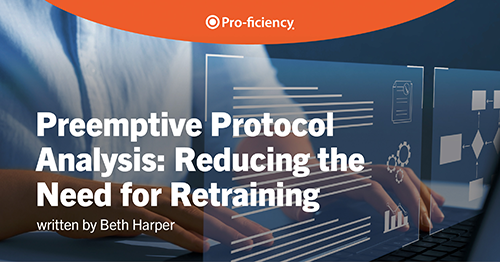Rethinking Training: Achieving Competency in Less Time and With Better Results
Training for clinical research staff that focuses on complete comprehension of a protocol and its goals can be a key factor in avoiding errors and protocol deviations during the course of a study. In fact, training, if done right, offers a unique opportunity to predict potential problems and address them before they occur.
At its foundation, training provided to research site employees is intended to ensure competency. Competent staff are less likely to make errors, meaning that the risk of protocol deviations goes down as site employee competency goes up. And reduced deviations can help to avoid study delays and keep costs—which have been trending upward, as have trial timelines—under control.
So it may seem self-evident that training provided to staff at clinical research sites is a critical opportunity to ensure peak performance and prevent protocol deviations that can derail a study.
But the clinical research industry traditionally has viewed the need for training as, at best, an item to check off a list in order to get a study off the ground and, at worst, a burden to sponsors and research sites alike.
This outlook has developed over years of a push-pull dynamic between sponsors’ need to comply with regulations that mandate training on study protocols and GCPs and sites’ desire for shorter training that poses a lesser burden to research staff. For instance, CenterWatch reported in August 2020 that training was a growing pain point for research sites, which were overwhelmed by growing administrative responsibilities, including undergoing GCP and protocol-specific training.
The FDA requires that all research personnel be adequately trained for their roles. The agency is largely focused on GCP compliance, as well as adhering to the protocol. And sponsors often focus on training as a risk mitigation exercise to ensure that they can demonstrate to the FDA that they have met their regulatory obligation in this area. In other words, it’s not uncommon for a sponsor or CRO to create training programs designed to do nothing more than check the “training” box on FDA paperwork.
And in an effort to cover all training bases, sponsors and/or CROs tend to provide training materials that are both massive in volume and overly generalized. One reason sites view training as a burden is the massive amount of information—often in slide decks numbering in the hundreds—sponsors tend to dump on researchers, rather than engaging with different roles and clarifying what is most important for a particular study.
A better approach would be to develop training that truly provides opportunity for individuals in clinical research to acquire, retain and apply knowledge.
Boost competency, reduce errors
Sponsors need sites to execute clinical trials as close to perfect as possible. In order for this to happen site employees need to consume content that will help them understand. But that is not enough to achieve the goal of optimized performance. Research staff also need to have enough understanding to ensure that they consistently make good decisions.
And that can’t be achieved through a slide deck, lecture or webinar. Research staff must be engaged with the content and provided an opportunity for “perfect practice,” where errors are caught and corrected before real-life stakes are in play.
Providing training in a simulation format can help solve these problems in several ways. Simulation-based training, such as the program offered by Pro-ficiency, provide research staff with hypothetical situations similar to those they will face during the study. They are then able to actually practice key tasks and procedures required under the protocol, getting guidance throughout the process to help ensure they make decisions correctly, in compliance with the protocol.
Additionally, the immediate feedback on mistakes that is built into Pro-ficiency’s method avoids the risk of staff developing “muscle memory” that is incorrect for performance of critical tasks. This can be particularly important when a protocol requires procedures that are different from the standard of care a site is used to practicing.
The dashboard of results like that provided by Pro-ficiency can highlight any weak areas to both sites and sponsors, allowing additional concentration on the troublesome areas—whether a tricky procedure or a less-experienced site or individual—and address problems before they occur in a real-life clinical trial. When training provides these types of analytics, sponsors can track where mistakes are most common and take appropriate action.
Actions available to sponsors in these cases can include providing an additional training module on a particular procedure or giving extra help and training to struggling sites or individuals.
It’s impossible to take a one-size-fits-all approach to competency management. The goal is to reduce errors as much as possible. But when they do happen, each situation should be evaluated independently. Additional training can solve some problems, but in other cases, a sponsor may be looking at a wrong investigator or site, for instance. In other words, improving human performance can save money and time.
This approach to training also lets research staff move at their own speed, whizzing through tasks in which they already are proficient and spending more time on novel, protocol-specific procedures.
But a high error rate is not always a negative during training. For instance, one Pro-ficiency client applied training for a highly complex protocol that was challenging for sites. When employees initially participated in the training, the analytics indicated a high error rate. However, once the study began, deviation rates were not high. This would seem to indicate that the training allowed them to safely make mistakes, correct them and better learn how to execute the protocol properly.
And for particularly complex or novel procedures, training can be repeated for research physicians or others responsible for those tasks. For example, the sponsor of a study where the protocol required novel needle path planning opted to provide the training for that procedure early to allow ample time for physicians at the research sites to become comfortable with the new method. Analytics showed that errors were common as sites went through that training the first time.
But the sponsor re-presented the same training just before the first patients would need to undergo the procedure. And at that point, the errors were significantly reduced, and performance during the clinical trial much improved.
And those two factors—an opportunity to practice the protocol in a consequence-free environment and getting real-time coaching during the training—are central to effective training that boosts staff competence, avoids protocol deviations and checks the regulatory “training” box.
Timelines for clinical trials are growing longer and costs are getting higher. Protocol deviations can be a major contributor to increases in both cost and time. Moving the needle toward fewer errors and deviations by even just 10% could make a significant difference in the resources needed to complete a clinical trial. And well-developed, well-applied, simulation-based training, while it can’t guarantee the perfect study, does offer the potential to alleviate some of these expense factors later on.
To learn more about Pro-ficiency’s simulation-based training solution, please visit our website: https://pro-ficiency.com/simulation-training

As Chief Experience Officer at Pro-ficiency, Jenna helps clients realize the full potential of their partnership with Pro-ficiency. Jenna has spent 16 years at the Association of Clinical Research Professionals (ACRP), including serving in various roles such as Business Development leader. Throughout her time at ACRP she helped hundreds of companies integrate competency-based learning, hosted by Pro-ficiency, into their workforce initiatives. In this work, Jenna began noticing her clients’ appreciation for the incredible Pro-ficiency platform, simulations, and customer service. Now, Jenna helps clients (including ACRP) realize the full potential of their partnership with Pro-ficiency.









Comments are closed.